In Praise of Shadows: An Imaginary Course Syllabus 
The thump of that party bus called summer feels long gone with fall’s forced entry into the Pacific Northwest last week (complete with tornado). Cooler and darker days are here to stay; pre-Halloween days good for ghost stories and tales of the supernatural. What follows is the syllabus for an imaginary course on the horror short story that you never asked to take.
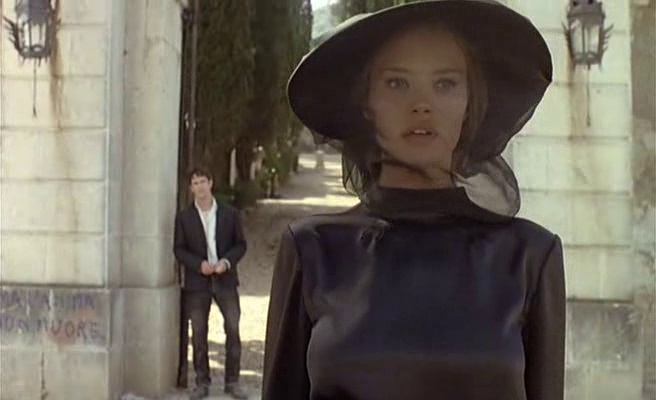
The stunning Anna Falchi as She in Cemetery Man, based on Tiziano Sclavi’s novel, Dellamorte Dellamore. Francesco Dellamorte (Rupert Everett) broods in the background.
SUPERNATURAL LITERATURE 107
INTRO TO THE HORROR SHORT STORY AS IT APPEARS ON MY BOOKSHELVES
IMAGINARY COURSE SYLLABUS
DESCRIPTION
This imaginary course is a superficial examination of the horror short story limited to what is found lurking on my over-burdened bookshelves. With a little prodding, the material arranges itself around the themes of the occult detective and the epistolary format, with a few exceptions that have nothing to do with either. The imaginary course reading is generally chronological and tends to bunch around the turn of the 20th century. For this reason and others besides, I have decided to compensate with a large helping of Clive Barker.
ORGANIZATION AND OBJECTIVES
This is a self-guided exploration that assumes no previous experience with the horror genre. With the exception of H.P. Lovecraft and Clive Barker, the map of your October reading below is intended to introduce you to overlooked authors. If you have read any horror shorts, it is likely that they come from either Edgar Allan Poe or Stephen King. For this reason these authors are absent from the list (and not for lack of appreciation). Most importantly, this imaginary course is designed to put you in the holiday spirit by month’s end and should in no way be considered as coming from an authoritative source. Give yourself a pop-quiz from time to time and if you are sufficiently motivated, a comprehensive final exam.
IMAGINARY COURSE TOPICS
1. The precursor to the occult detective: Sheridan Le Fanu’s Dr. Martin Hesselius.
2. The arbitrary machinations of a court that appeals to a “higher authority†that the accused is not familiar with.
3. The lesbian vampire (Le Fanu’s “Carmilla”).
4. Building suspense via the unreliable narrator in the epistolary format.
5. The evolution of the fictional scholarly essay title, from Dr. Hesselius penning, “The Interior Sense and the Conditions of the Opening Thereof†to Carnacki’s light reading: “Astral Vibrations Compared with Materio-involuted Vibrations Below the Six-Billion Limitâ€.
6. The occult detective’s admiring sidekick as narrator.
7. Modes of psychic self-defense: electric pentacles vs. guns.
8. Science fiction in the horror short story (Lovecraft).
9. The Hermetic Order of the Golden Dawn connection (Blackwood and Fortune).
10. The important role Weird Tales plays in the horror short story.
11. Explaining vampirism.
12. The peculiar smell of the supernatural.
13. The burnous as cultwear.
14. The cemetery watchman as engineer.
TOOLS AND TEXTS
1. To meet the imaginary course objectives, a brain lacking sleep is required to sufficiently blur the edges of reality.
2. A library card or…
3. …it pains me to say it, but: an eReader. It would be very useful – but not necessary - for this imaginary course since selections are from a variety of collected works that would otherwise be difficult and expensive to acquire all at once. All texts are available as Kindle eBooks.
4. Whenever possible I have limited selections from each author to a single volume of collected works. The short stories are as follows:
(Oct. 7-8) “Mr. Justice Harbottle†and “Carmilla†from Sheridan Le Fanu’s In a Glass Darkly (originally published in 1872). “Carmilla” needed some coaxing to stand under the epistolary format umbrella, since it only seems to be written as a letter. This story is said to have been the inspiration for fellow Irishman Bram Stoker’s Dracula:
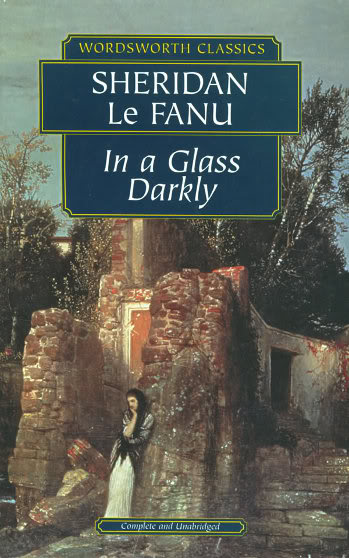
(Oct. 9) “Good Lady Ducayne” (originally published in The Strand Magazine, 1896). A different kind of vampire story from M. E. Braddon’s At Chrighton Abbey and Other Horror Stories:

(Oct. 10-11) “The Listener” from Algernon Blackwood’s The Listener and Other Stories (originally published in 1907). The best example in this list of the suspense that builds in the epistolary format. Read it for free here:
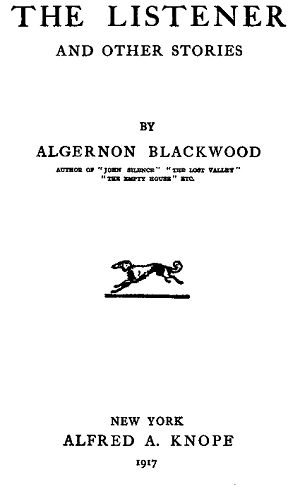
(Oct. 12-14) “The Camp of the Dog” from Blackwood’s John Silence: Physician Extraordinary (originally published in 1908):

(Oct. 15-17) “The Whistling Room” (originally published in The Idler, 1910). Read it for free here. “The Hog” (published posthumously in Weird Tales, 1947) from William Hope Hodgson’s Carnacki the Ghost-Finder:

This, above any other book cover I have, creeps me out the most.
(Oct. 18-20) “A Daughter of Pan”, “The Soul That Would Not Be Born” and “The Power House” (I can only imagine Fortune drew on Aleister Crowley’s reputation for this. As a side note, Crowley himself makes many contributions to the horror short that are worth pursuing.) from Dion Fortune’s The Secrets of Dr. Taverner (originally published in 1926). A fascinating character in her own right, Fortune (Violet Firth) allegedly based Secrets on her experiences with Theodore Moriarty:
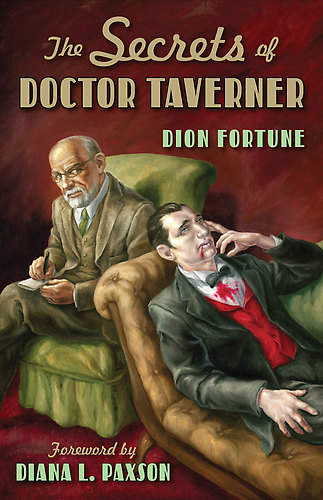
(Oct. 21-23) “The Silver Key” (a Randolph Carter story originally published in Weird Tales, 1926) and “The Whisperer in Darkness” (touching on the Cthulhu Mythos with sci-fi leanings, originally published in Weird Tales, 1931) from H.P. Lovecraft’s Bloodcurdling Tales of Horror and the Macabre:

* For your first extra credit assignment seek out “Through the Gates of the Silver Key”, another Randolph Carter story Lovecraft co-wrote with E. Hoffmann Price that, in my opinion, is an astonishingly masterful piece of work.
(Oct. 24-28) We’re going to span a fifty-year gap to get gory. “The Book of Blood”, “The Midnight Meat Train” (yes, that’s Bradley Cooper in the movie version) and “In the Hills, the Cities” from Clive Barker’s Books of Blood Volume One (1984). If you like this then lucky you. There are fives more volumes to go:

(Oct. 29) Lord of Illusions (1995), based Barker’s short story, “The Last Illusion”. This is one of the rare times I’ll recommend a movie over the story it was based on. In this case, the movie was written and directed by Clive Barker himself so I consider it more of a revision. Main character Harry D’Amour is less occult detective and more a private detective that keeps having run-ins with the occult, but that’s nitpicking:
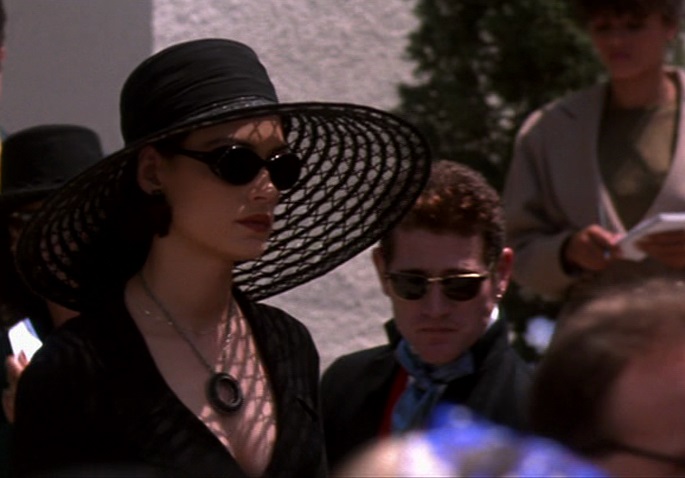
Also gorgeous and newly widowed is Dorothea Swann (Famke Janssen) in Clive Barker’s Lord of Illusions.
(Oct. 30) I really wanted to round out the occult detective theme with a field trip to comics land, but Dark Horse’s Dylan Dog Case Files (2009) by Tiziano Sclavi is out of print and not easy to find outside of the internet. It is your second extra credit assignment:
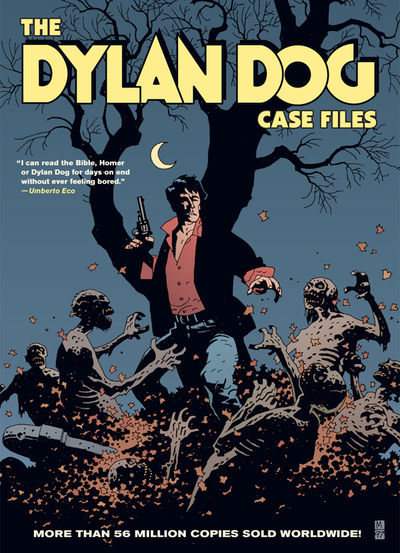
With seven case files and 680 pages you can’t fail to admire its struggle toward cubishness if you do happen to see it in a comic or second-hand book shop.
Here’s the next best thing and your last assignment: Cemetery Man(1994). A cult classic and the only existential zombie flick I’ll ever recommend. It is based on Sclavi’s novel, Dellamorte Dellamore. Rupert Everett is delightful as Francesco Dellamorte, a melancholic cemetery watchman who reads phonebooks and can’t distinguish the living dead from the dying living. Everett models Dylan Dog’s signature look throughout the film:

GRADING
Completed imaginary coursework will reflect favorably on your permanent record. Completed extra credit reading will be reflected even more favorably on your permanent record.














October 7th, 2013 at 11:55 pm
Can I get extra credit for watching Chopper Chicks in Zombie Town? A Billy Bob Thornton thriller! Trailer at
www.youtube.com/watch?v=HuMnDdLitWI‎